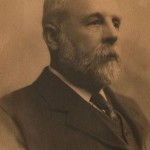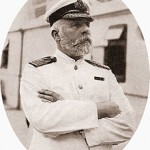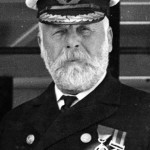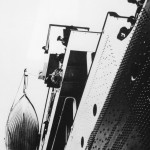 When Titanic sank into the frigid waters of the North Atlantic Ocean in the wee hours of April 15th, 1912, the answers to many questions vanished with her. Those who were left behind to mourn their dead and, in some cases, without having remains to lay to rest, did so without answers from The White Star Line. Among the lost was Titanic’s captain, Edward James Smith, a man who might have been able to provide answers to those looking for them. However, Smith’s last days and in particular his final moments aboard Titanic remain shrouded in myth and mystery, from how he dealt with the evacuation of the ship to where and how he died.
When Titanic sank into the frigid waters of the North Atlantic Ocean in the wee hours of April 15th, 1912, the answers to many questions vanished with her. Those who were left behind to mourn their dead and, in some cases, without having remains to lay to rest, did so without answers from The White Star Line. Among the lost was Titanic’s captain, Edward James Smith, a man who might have been able to provide answers to those looking for them. However, Smith’s last days and in particular his final moments aboard Titanic remain shrouded in myth and mystery, from how he dealt with the evacuation of the ship to where and how he died.
1. A Proud Nautical Past
 Captain Smith joined the White Star Line in 1880, as a fourth officer of the S.S. Celtic. It took him only seven years to earn his first command for the company. In 1888, he joined the Royal Naval Reserve and earned a lieutenant’s rank. He earned several medals for his reserve service and by 1905, he’d risen through the ranks to commander. Around this time, the White Star Line put Smith in charge of the maiden voyages of its ships, including the Baltic, the Adriatic, and the Olympic. First officer William Murdoch, who would serve in the same capacity on Titanic, was Smith’s right-hand man on Olympic as well.
Captain Smith joined the White Star Line in 1880, as a fourth officer of the S.S. Celtic. It took him only seven years to earn his first command for the company. In 1888, he joined the Royal Naval Reserve and earned a lieutenant’s rank. He earned several medals for his reserve service and by 1905, he’d risen through the ranks to commander. Around this time, the White Star Line put Smith in charge of the maiden voyages of its ships, including the Baltic, the Adriatic, and the Olympic. First officer William Murdoch, who would serve in the same capacity on Titanic, was Smith’s right-hand man on Olympic as well.
2. Captain EJ Smith on Board Titanic
 Despite her maiden voyage being delayed due to the Olympic needing repairs after a moderately collision with a warship, Titanic was ready to set sail by early April, 1912. Smith boarded her on April 10th, around 8 a.m., and the ship departed at noon. Another mishap nearly occurred when waves created by the giant ship caused another to snap away from its moorings. It nearly struck Titanic, but Smith was able to maneuver out of its way. One cannot help but wonder if the collision had happened how it might have changed the fates of those aboard.
Despite her maiden voyage being delayed due to the Olympic needing repairs after a moderately collision with a warship, Titanic was ready to set sail by early April, 1912. Smith boarded her on April 10th, around 8 a.m., and the ship departed at noon. Another mishap nearly occurred when waves created by the giant ship caused another to snap away from its moorings. It nearly struck Titanic, but Smith was able to maneuver out of its way. One cannot help but wonder if the collision had happened how it might have changed the fates of those aboard.
![]() The first days of Titanic’s voyage was uneventful for Smith, although he did receive reports of icebergs as they steamed through the North Atlantic toward New York City. However, on the morning of April 14th, multiple warning messages about ice began to come in from other ships. It is not fully known why Smith disregarded so many messages, especially considering his sailing experience, but it could be that he was facing pressure from Bruce Ismay, co-designer of Titanic and chairman of the White Star Line, to break speed records set by other ocean liners. Multiple wireless messages for first-class passengers were also causing wireless operators to cut ice warnings off and ease the swell of incoming transmissions.
The first days of Titanic’s voyage was uneventful for Smith, although he did receive reports of icebergs as they steamed through the North Atlantic toward New York City. However, on the morning of April 14th, multiple warning messages about ice began to come in from other ships. It is not fully known why Smith disregarded so many messages, especially considering his sailing experience, but it could be that he was facing pressure from Bruce Ismay, co-designer of Titanic and chairman of the White Star Line, to break speed records set by other ocean liners. Multiple wireless messages for first-class passengers were also causing wireless operators to cut ice warnings off and ease the swell of incoming transmissions.
3. Last Moments on the Bridge For Captain Smith
Captain Smith was off duty and asleep when Titanic struck an iceberg at approximately 11:20 p.m. on April 14th. Once he was awoken and given information on the collision, the captain probably realized there were not enough lifeboats to accommodate all his passengers but gave the order to start evacuating the ship nonetheless. He managed the situation as any ship’s captain might, ordering women and children off the doomed ocean liner and managing his crew. According to most accounts from passengers and crew, Smith did not falter as the situation grew progressively worse.
 Myth and mystery factor in heavily when it comes to Captain Smith’s final words and moments. Some say that his last words to his crew were “Be British, boys, be British!” However, the last confirmed sighting of Smith was at 2:10 a.m., ten minutes before the final plunge, when he shouted to his crew, “Well boys, do your best for the women and children, and look out for yourselves!” He was then seen heading toward the bridge, where he most likely remained. Several people claimed they saw Smith dive from the ship during the final moments of the sinking, but since others claimed they saw him save a child by carrying him to a lifeboat before being swept away by the sea and some claim they saw Smith shoot himself as the ship went down, it is impossible to guess the reality of his final moments. Sadly, his body was never recovered.
Myth and mystery factor in heavily when it comes to Captain Smith’s final words and moments. Some say that his last words to his crew were “Be British, boys, be British!” However, the last confirmed sighting of Smith was at 2:10 a.m., ten minutes before the final plunge, when he shouted to his crew, “Well boys, do your best for the women and children, and look out for yourselves!” He was then seen heading toward the bridge, where he most likely remained. Several people claimed they saw Smith dive from the ship during the final moments of the sinking, but since others claimed they saw him save a child by carrying him to a lifeboat before being swept away by the sea and some claim they saw Smith shoot himself as the ship went down, it is impossible to guess the reality of his final moments. Sadly, his body was never recovered.
While the final moments of Captain Smith remain shrouded in mystery, he was posthumously found not responsible for the sinking. His legacy stands as one of bravery in the face of disaster and as one of leadership for those who remember Titanic and her brave crew.

